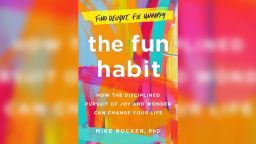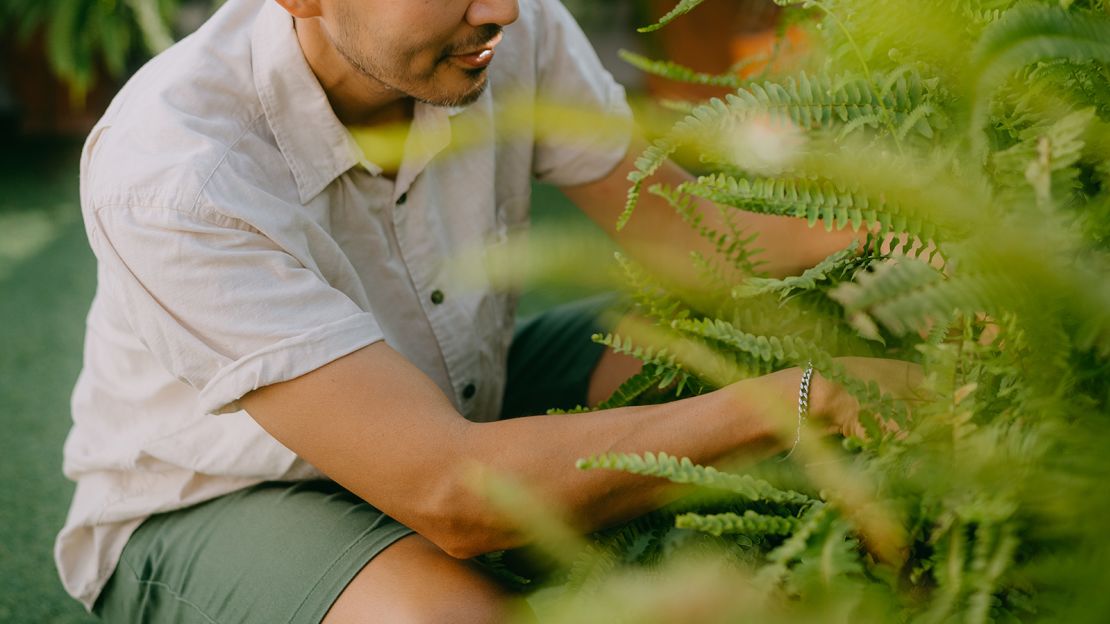Editor’s note: Sign up for CNN’s Stress, But Less newsletter. Our six-part mindfulness guide will inform and inspire you to reduce stress while learning how to harness it.
In a society that prizes productivity, where busyness becomes a point of pride and the “grind” a badge of honor, fun too often gets cast aside as trifling rather than a vital part of a meaningful life.
In his science-backed guidebook, “The Fun Habit: How the Pursuit of Joy and Wonder Can Change Your Life,” organizational psychologist and behavioral scientist Mike Rucker shares evidence for the physical and psychological benefits of prioritizing pleasure.

A component of our well-being relies on fun, play and leisure, Rucker argues. His book explains how intentionally increasing joyful moments can improve health, relationships — and even productivity — and offers practical tips, tools and tactics to encourage everyday acts of fun.
Fun isn’t “extra,” Rucker insists. “It’s an act of radical self-care.”
This conversation has been edited and condensed for clarity.

CNN: What is fun? How is it different from happiness?
Mike Rucker: Happiness is outcome-focused. Too often, instead of mindfully enjoying what life has to offer, we’re using energy to unpack why we are or are not happy. We can get stuck in ruminating on the gap between where we think we are and what we think happiness is supposed to be like.
Fun is less “think” and more “do.” It’s demonstrable, observable, real and immediately within our grasp. Are you drawn to, finding pleasure in and engaged with an activity? That’s fun. Available to anyone at almost any time, fun offers a direct neurological route to improving our well-being.
It doesn’t need to be something whimsical either. Quiet, low-arousal activities that provide balance and renewal — like gardening, meditating or reading — count as fun.
CNN: What effect does nurturing a fun habit have on our lives?
Rucker: Too often we look at our lives through the lens of productivity rather than based on what would be restorative or enjoyable.
A fun habit aligns with being more productive and living a meaningful life. Asking, “How can I enjoy this?” helps us identify elements that we can manipulate, including our environment, the people we’re with and the activities we’re engaged in. It helps if we ask, “Are there ways to reengineer these elements for more enjoyment?”
Developing a bias toward fun can skew the balance of our experiences toward more good than bad. Laughter and good humor reduce anxiety, decrease stress, enhance self-esteem and increase self-motivation. A fun-focused framework can also help us learn to enjoy ourselves even when things don’t go our way.

CNN: What practical steps can we take to have more fun?
Rucker: The first step toward adding novel, pleasurable activities to your daily life is to audit your calendar for fun instead of productivity. Doing so will uncover hidden opportunities to increase your fun, even without sacrificing getting things done.
For one week, you could try logging your activities by the hour. You can download my free time tracker to help. Next, categorize how you’re spending your time using my simple four-quadrant PLAY model, which plots activities along the axes of enjoyment and effort. Activities that are both easy and highly enjoyable belong in the upper left “pleasing” quadrant. While time spent here often gets billed as frivolous, research tells us these activities create the feeling that our life is worthwhile and fulfilling.

CNN: Is the goal to spend our whole lives in the “pleasing” quadrant?
Rucker: Not at all. A full life includes ups and downs, joys, pains and tedium. The toxic positivity reflected in the “good-vibes only,” “no bad days” messaging by some in the happiness-industrial complex reflects a problematic lack of emotional flexibility. Unlike happiness, fun can coincide with a variety of emotional states or even transcend them altogether.
CNN: Once we’ve tracked how we’re spending our time, how do we tip the scales toward fun?
Rucker: Activity tracking can help us take agency to free up more time for fun. Because it’s human nature to quickly fill up any space we create, I suggest coming up with what I call a fun file — a robust list of fun activities you’d like to integrate into your days. List-making helps flex our curiosity, along with giving us a go-to resource to draw from. Once you have your long list, break it into categories and then winnow it down to a short list of eight to 15 achievable options. The brain performs well with that many choices.
CNN: Why is it so important to prioritize pursuing these activities in our already time-starved lives?
Rucker: Fun is the antidote to life’s slings and arrows. A tool for enrichment and a relief valve for life’s pressures, fun keeps us healthy. It also helps us make overall better use of the time we do have. Studies suggest that people who are deliberate about making sure that they reserve time for fun, renewal and doing interesting things are the most productive people. Plus, folks that aren’t having fun look for poor forms of escapism.
Say you think you’re a hustler and you’re working 60 hours a week, generating one unit of output each hour. Compare that with folks that are having fun — who we know, based on the science, are more productive. They can actually produce more output units for each hour of work.
Even beyond quantity, we see that the most innovative and creative work comes from those who protect their leisure. Time for fun frees up the ability for nonlinear thinking.
CNN: Who has access to carve out time for fun?
Rucker: As with most things, privilege does open doors for fun. The ability to exchange time for money, as effective as it is, is rooted in privilege. That said, time-use data shows that even the most time-poor folks generally have periods in each day where they have some control over what they’re doing. If you get creative, there’s a whole host of ways to increase your time affluence without needing money.
Grouping activities can be one way to become more efficient. For example, a doctor I worked with enjoyed drawing but had a hard time fitting it into her schedule until she started drawing while making follow-up responses to patients. Collaborating with members of your community can help, too. Childcare swaps can free up parents for a lower-cost date night. And online resources offer great options for free activities with like-minded individuals.
CNN: How much time should we spend on fun each day?
Rucker: Research suggests two hours each day as the “Goldilocks spot” for spending time on fun. In a society that requires so many work hours and devalues the importance of fun, that might seem like a lot. If that feels like a stretch, start with taking one to three hours a week to test out some of the items on your fun list. Don’t think that you have a 14-hour mandate right away. Even a slow ramp-up will show you the benefits of this new habit. Once people realize that they will actually be more productive by having fun, this approach becomes an easier sell.
CNN: How does journaling support building a fun habit? What specific practices help the most?
Rucker: Journaling helps us store memories and process our experiences. Entries that focus on savoring or reminiscing amplify the power of fun that you’ve already had because you get to reexperience it. The key is to include memorable details about the experience you’re describing. Why was it fun? How did you feel? What about the memory lights you up? Include sensory details and, if you can, an anchoring artifact — a photo, song lyric or video clip, for example. Anchors can help our recall, bringing back information that’s been encoded in our brain.
Remember that journaling doesn’t necessarily have to happen on pen and paper. A scrapbook, a memory jar, all these things can be extremely helpful. No matter how you catalog, these memories can lure you back into more of what you’ve enjoyed in the past.
By drawing our attention to good times that we’ve had — and could have again — reminiscing raises our awareness that we have more agency and autonomy to affect the way we’re moving through time than we sometimes think. Research shows that documenting and activating positive memories bring long-term benefits and can even help suppress depression. Plus, fun memories help us build resources that offer emotional resilience during not-so-fun times.
Fun allows us to cope with life’s pain, and sometimes even transcend it, by more fully experiencing life’s gifts.
Jessica DuLong is a Brooklyn, New York-based journalist, book collaborator, writing coach and the author of “Saved at the Seawall: Stories From the September 11 Boat Lift” and “My River Chronicles: Rediscovering the Work That Built America.”





